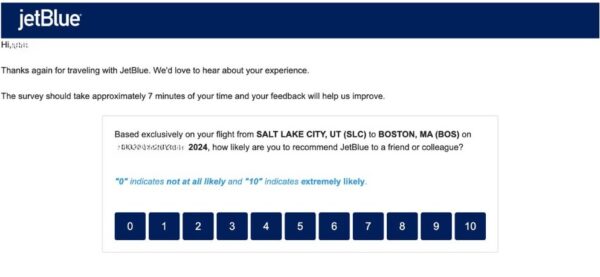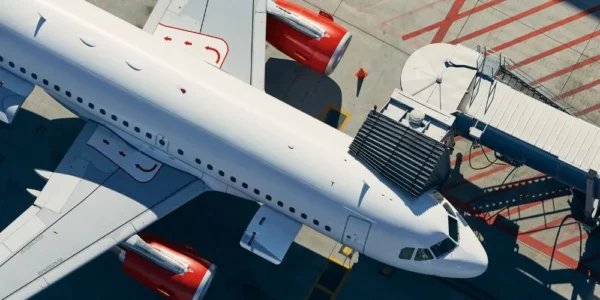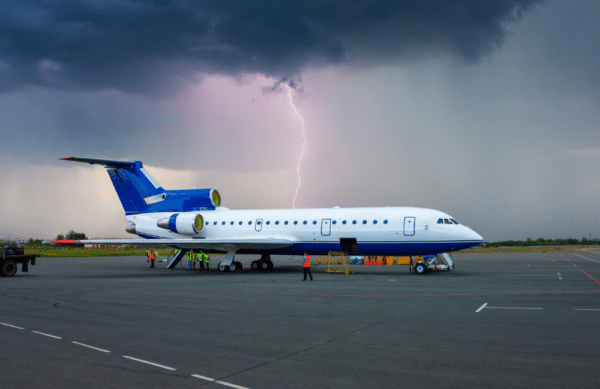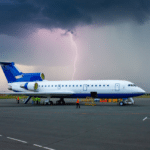TL;DR:
- Air travel is routine, but airlines can enhance customer satisfaction by improving the overall experience.
- Weather-related challenges impact customer satisfaction and operational efficiency in the aviation industry.
- Leveraging weather intelligence can help airlines reduce delays, optimize operations, and improve customer happiness.
- JetBlue’s use of weather intelligence has led to substantial cost savings and a high NPS score.
- Innovative solutions and safety protocols can help airlines maintain customer satisfaction during weather disruptions.
Did you know that more than 8 billion people flew on a plane in 2023?
Air travel is so routine that we don’t think about everything that goes into making a positive airline customer experience.
From the check-in desk to the actual in-air experience, there are many areas airlines could strategically enhance to improve customer satisfaction.
Just think about the current process: passengers rush to the airport in the early hours of the morning, wait in long lines to check bags, and take shoes and belts and jewelry off for a pat-down…only to sit around concourses with pre-packaged food for hours after weather-related flight delays.
It’s clear why some airline NPS scores have been low in past years and are only now starting to bounce back.
When it comes to customer satisfaction, NPS scores, and other major customer experience KPIs, airlines are often playing catch up.
But it doesn’t have to be that way when it comes to weather-related challenges.
This blog will cover how space-based, AI-backed weather intelligence can actually help airlines improve customer happiness and drive more repeat business. We’ll explore how weather intelligence optimizes operational efficiency across the aviation industry by minimizing delays, fine-tuning scheduling, and reducing costly weather-related expenses. You’ll learn real-world examples, including a case study on JetBlue’s innovative application of weather data to simultaneously improve the customer experience and realize substantial cost savings
The Current State of Customer Satisfaction in Aviation
Amidst the soaring numbers of air travelers, customer satisfaction within the airline industry remains turbulent.
Lengthy security lines, overcrowded terminals, and frequent delays leave passengers feeling frustrated and disenchanted.
According to J.D. Power’s 2023 North America Airline Satisfaction Study, overall traveler satisfaction continues to decline, being down 7 points from the previous year and an overall 29 points from 2021. The current score sits at 791. This downward trend highlights the pressing need for airlines to prioritize the end-to-end customer experience.
From check-in to baggage claim, every touchpoint represents an opportunity to cultivate loyalty or exacerbate dissatisfaction. As competition intensifies, airlines must innovate to elevate service quality, lest they risk losing altitude in customer retention and acquisition.
Other studies show that JetBlue Airways and Delta Air Lines have been recognized for their high customer satisfaction scores in respective segments. JetBlue ranks highest in the first/business class segment with a score of 893 and Delta sits with a score of 848 in the premium economy segment.
The American Customer Satisfaction Index (ACSI) for 2023 for airlines shows a more positive customer experience trend with scores up across individual experience benchmarks including mobile app quality and reliability, website satisfaction, ease of check-in, ease of reservations, and more.
How to Measure Airline Customer Satisfaction with NPS
A common way companies measure customer satisfaction is through a metric called NPS, or net promoter score.

JetBlue NPS Survey
An NPS score indicates how loyal a customer is to a given airline — measured through a single-question survey asking, “How likely are you to recommend [AIRLINE] to a friend or colleague?
Respondents give a rating of 0 (not at all likely) to 10 (extremely likely) and the final percentage is calculated by subtracting detractors (the percentage of people who rated from 0-6) from promoters (the percentage of people who rated 9-10). This gives an NPS score from anywhere from -100 to 100.
The average airline NPS score is 28, which is lower than past year but on parr with what the industry is seeing post-COVID. Airlines vary drastically in NPS worldwide, with RyanAir coming in with an NPS of -61 and Alaska Airlines scoring a +71.

Top Airlines’ NPS Score via Comparably.com
Airlines have a long way to go to improve their customer satisfaction scores — despite investing more than $1.3 billion per month in engaging customers. While airlines have wowed passengers with the highest satisfaction scores in recent years, it’s still not enough to build a customer base that will choose your commercial airline no matter the price or timing.
Airlines need to find other paths toward improving customer satisfaction and overall NPS. One way airlines are doing this is by leveraging weather intelligence to reduce delays and cancellations and overall operational performance.
Using Weather Intelligence to Build a Better Airline Customer Experience
While there’s plenty that airlines can control, like in-flight entertainment deals, meal offerings, and fees and policies, there’s one aspect that dramatically impacts the customer experience that you can’t control: the weather.
Snow, ice, turbulence, thunderstorms, high winds, and more can delay takeoffs and wreak havoc with scheduling. Not only do weather-related delays play a huge role in customer satisfaction, a flight delay of just one hour can cost airlines up to $4,500 and increasing in recent years.
Luckily, technology has come a long way in helping organizations prepare for the weather before it arrives.
Weather intelligence is at the forefront of providing cutting-edge weather intelligence solutions tailored to the aviation industry. Tomorrow.io’s AI-powered platform ingests a vast array of meteorological data from multiple sources, enabling highly accurate forecasts down to a granular level.
Airlines can leverage these hyper-local predictions to make informed decisions that mitigate disruptions, optimize flight routes and ground operations. Tomorrow.io’s aviation weather intelligence encompasses real-time monitoring of turbulence, icing risks, thunderstorm tracking, and even runway condition analysis.This level of weather insight allows carriers to enhance safety, improve on-time performance, and ultimately elevate the entire customer experience through the intelligent management of weather events.
Take JetBlue, for example.
Like most major airlines, one of the biggest challenges JetBlue faces is how to operate safely and efficiently, especially in difficult weather conditions. JetBlue’s team uses Tomorrow.io to track specific weather insights that impact business operations and safety. In addition, automated alerts and team protocols go live before such weather approaches.
How JetBlue Uses Weather Intelligence
*Learn more about how JetBlue uses Tomorrow.io to make critical weather decisions.
The crew at Boston Logan International Airport is no stranger to snowy winter weather. When snowstorms are in the forecast, no airline wants to mess around with dangerous conditions, which is why one February morning, every airline canceled regularly scheduled takeoffs until 11 AM — except for JetBlue.
That’s because Tomorrow.io pinpointed the exact timing of the snowfall ending at 8 AM instead, giving them time to jump into action, running operations seamlessly and keeping their customers happy.
“I’ve personally witnessed Tomorrow.io pick up ground-level weather systems that no one else could observe. Since I’ve put the Tomorrow.io tool in the hands of our managers, I get non-stop requests from leaders who want access, from ops managers, de-icing leaders, to ground operations duty managers. This tool was designed with an understanding of the decision-making pressure airport leaders face every day. JetBlue is looking forward to expanding our use of Tomorrow.io’s solution.” Ian Deason, Senior Vice President of Customer Experience, JetBlue
JetBlue estimates Tomorrow.io is saving the operations team as much as $50,000 per month per hub, especially during months with volatile weather. More importantly, though, JetBlue is able to proactively communicate with customers, rebook flights with plenty of lead time and notice, and ensure that weather-related delays are handled so customers feel confident that JetBlue will take care of their needs — and get them where they need to go.
It’s no surprise, then, that JetBlue’s NPS score in 2021 is a whopping 68, nearly double the average score of other airlines.
How To Improve Airline NPS with Weather Intelligence
The impact of weather in aviation is substantial, often indicated by delays, diversions, and cancellations.
According to the FAA, weather is the cause of nearly 75% delayed or canceled flights. This figure not only represents logistical headaches but also has significant financial implications with other research indicating that canceled flights cost an average of $5,770 per flight based on the airline.
Addressing Delays, Diversions, and Cancellations Effectively
To address these disruptions effectively, airlines can opt for innovative solutions that leverage advances in technology and communication tools.
These tool should be able to help address delays from high-impact weather including lightning, storm delays, snow storm disruptions, flooding, and other weather events.

Tomorrow.io’s Aviation Industry Weather Templates
Innovative Solutions for Managing Flight Disruptions due to Weather Conditions
For instance:
- Real-time tracking systems offer accurate information about prevailing weather conditions.
- Singe-view platforms for aviation specific weather templates
- Machine learning algorithms assist in predicting potential disruptive events.
- Integrated apps provide passengers up-to-date info about changes in itineraries promptly.
Through this proactive approach towards management and communication during inclement weather conditions, airlines can maintain customer satisfaction despite unforeseen circumstances.
Ensuring Passenger Safety Amidst Weather Hazards
Ensuring passenger safety during adverse weather conditions is also crucial. Airlines should have robust safety protocols in place when facing such challenges.
Implementing Safety Protocols and Measures during Adverse Weather Conditions
These might include prep work done way before take-off like deicing procedures or post-takeoff measures that allow planes to safely navigate through stormy areas. Notably, these protocols should not only be implemented but must be transparently communicated to passengers for their reassurance and confidence in their chosen airline’s ability to keep them safe even under strenuous weather situations.
Optimizing Operations by Minimizing Unnecessary Windows of Caution
Overcautiousness can bring undue pauses in operations causing further inconveniences for both the customers and the airline service line staff likewise. Therefore, striking a balanced level of cautionary measures is essential and doable with AI-backed decision support for weather-related operations.
Efficient Strategies to Reduce Operational Halts
To achieve this, airlines might consider options such as:
- Employing advanced navigation systems that aid pilots in avoiding areas with severe turbulence or storms.
- Leveraging weather intelligence that highlights pockets of time to improve decision support
- Using intelligent software systems capable of calculating optimal alternate routes using most updated weather data for diversions caused due to poor visibility.
Implementing these strategies can help airlines continue services smoothly without compromising passenger safety.
Enhancing Positive Customer Experiences despite Weather Challenges
Regardless of the unavoidable agreements that weather disruptions bring, there are still ways an airline can enhance positive customer experience.
Creative Approaches to Improving Passenger Satisfaction during Weather-related Disruptions
These could involve:
- Offering amenities like meal vouchers and hotels to inconvenienced passengers.
- Adopting a proactive communication strategy about any likely delay or cancellation.
Each step towards considering and pleasing the dissatisfied passenger leads towards higher levels of airline customer satisfaction ultimately achieving loyalty and trust.
Airlines Make the Most With Tomorrow.io
Take control of the number one detractor to customer satisfaction for the airline industry: the weather. Reduce delays with 24/7 hyperlocal minute-by-minute operational impact insights based on historical, real-time, and forecasted weather.
With Tomorrow.io, see exactly when, where, and how the weather is going to impact your airline in one simple dashboard, from deicing scheduling to lightning delays to snow accumulation.
Interested in what weather intelligence can do for your airline’s NPS?
Learn what airlines are doing to future-proof their operations today or book a call to learn more.










